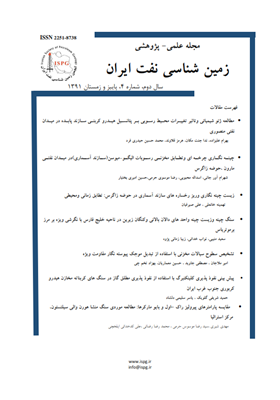سنگ چینه وزیست چینه واحد های دالان بالائی وکنگان زیرین در ناحیه خلیج فارس با نگرشی ویژه بر مرز پرموتریاس
محورهای موضوعی :سعیده منیبی 1 , نواب خدائی 2 , زیبا زمانی پژوه 3
1 - پژوهشگاه صنعت نفت
2 - پژوهشگاه صنعت نفت
3 - پژوهشگاه صنعت نفت
کلید واژه: دالان بالائی کنگان زیرین زون تجمعی مرز پرموتریاس ناپیوستگی همساز ,
چکیده مقاله :
واحد های سنگ چینه ای دالان بالائی وکنگان زیرین به ضخامت 225 متر در یکی از برش های تحت الارضی ناحیه خلیج فارس مورد مطالعه قرار گرفت .بر اساس مطالعات زیست چینه ای بر روی توالی های دولومیتی وآهکی واحد دالان بالائی بیش از 30 گونه از فرامینی فرهای شاخص به همراه چندین گونه غیر فرامینی فری شناسائی شده است .بر اساس مطالعات مذکور یک زون تجمعی Paradagmarita/Paraglobivalvulina/Baisalina Assemblage Zone که به 3 زیر زون تجمعی مجزا تفکیک می شود : 1. Rectostipulina quadrata/Globivalvulina vonderschimitti Assemblage subzone 2. Dagmarita chanackchiensis /ichtyolaria latilimbata Assemblage subzone 3. hemigordiopsis renzi/ paradagmarita flabeliformis Assemblage subzone به سن جلفین تا دوراشامین آغازی که در واحد سنگ چینه ای داالان بالائی شناسائی گردید .زون های تجمعی مذکور همراه با ویژگی های سنگ چینه ای آن با توالی ها وزون های تجمعی پرمین بالائی در حوضه تتیس مطابقت زیادی دارند .زون های تجمعی فوقانی ترین بخش واحد دالان بالائی نشان می دهد که مرز سازند های دالان وکنگان (پرمو تریاس )در این ناحیه با یک ناپیوستگی همساز همراه است ،بطوریکه شواهدی از وجود رسوبات مربوط به اشکوب دوراشامین انتهایی در این ناحیه یافت نگردید .نا پیوستگی رسوبات در مرز پر موتریاس باعث انقطاع زون های زیستی اواخر پرمین در این ناحیه بوده که تاثیر آن با سایر نقاط دنیا قابل مقایسه است .واحد سنگ چینه ای کنگان زیرین تنها بر اساس چندین جنس از دو کفه ای ها(کلارایا )وسرپیولید ها (اسپیروربیس)به اشکوب اسکیتین (اوایل تریاس زیرین )نسبت داده می شود. این نکته لازم به ذکر است که اجتماع فسیلی فوق الذکر در سایر نواحی ایران نظیر ایران مرکزی والبرز نیز مشاهده شده اند که از ارتباط پالئوبیوژئوگرافی نواحی مذکور با اقلیم زاگرس در زمان های پرمین وتریاس حکایت دارد .
Abstract The Upper Dalan and Lower Kangan stratigraphic units with 225m thickness were studied in one of the subsurface section in Persian Gulf area. According to the biostrarigraphic investigation on the dolomitic and limestone successions of the Upper Dalan unit, there are more than 30 index foraminifera and non-foraminifera species. One Paradagmarita/ Paraglobivalvulina/ Baisalina Assemblage Zone that divided to three distinct sub- assemblage zones 1. Rectostipulina quadrata/ Globivalvulina vonderschimitti Assemblage subzone 2. Dagmarita chanackchiensis/ Ichtyolaria latilimbata Assemblage subzone 3. Hemigordiopsis renzi/ Paradagmarita flabeliformis Assemblage subzone have been distinguished in the stratigraphic section representing the Julfian to Earleast Dorashamian stage. The identified microfauna' assemblages can be corresponded to the Late Permian regional biozonation in the Tethys realm. The latest microfauna assemblages in the latest part of Dalan Formation exhibits a significant chronostratigraphic hiatus, just was cited in the Dalan/ Kangan (Permo/Triassic) boundary. There is no any evidence about Latest Dorashamian sediments in the study area. The Permo/Triassic boundary is a paraconformity type in the latest Permian biozones, which can be corresponded to other areas of the world. The Lower Kangan stratigraphic unit can be attributed to the Schytian age (Early Triassic age) on basis of presence of some index fossils such as Bivalves (Claraia sp.) and Serpulids (Spirorbis sp.). It should be stressed that the similar microfauna associations can be seen in other Iranian places such as Central Iran and Alborz areas, which is documented a distinct palaeobiogeographical relationship between the above-mentioned areas and Zagros realm on Permian and Triassic ages.


